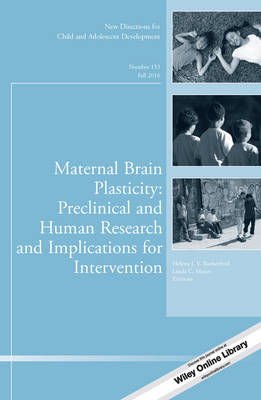
Maternal Brain Plasticity: Preclinical and Human Research and Implications for Intervention
John Wiley & Sons Inc (Verlag)
978-1-119-31848-4 (ISBN)
- Titel ist leider vergriffen;
keine Neuauflage - Artikel merken
This is the 153rd volume in this Jossey-Bass series New Directions for Child and Adolescent Development. Its mission is to provide scientific and scholarly presentations on cutting edge issues and concepts in this subject area. Each volume focuses on a specific new direction or research topic and is edited by experts from that field.
Volume Editors: Helena J. V. Rutherford, PhD, Assistant Professor, Yale Child Study Center. Linda C. Mayes, MD, Arnold Gesell Professor of Child Psychiatry, Pediatrics, and Psychology, Director, Yale Child Study Center; Special Advisor to the Dean, Yale School of Medicine; Distinguished Visiting Professor of Psychology, Sewanee: The University of the South. Series Editor: Elena L. Grigorenko is the Emily Fraser Beede Professor of Developmental Disabilities (Child Study Center, the Department of Epidemiology & Public Health) at Yale University.
Introduction to Maternal Brain Plasticity 7 Helena J. V. Rutherford, Linda C. Mayes 1. Plasticity of the Maternal Brain Across the Lifespan 9 Frances A. Champagne, James P. Curley Maternal behavior is dependent on hormone sensitivity within hypothalamic brain regions and neural activation within mesolimbic dopamine circuits that regulate salience and motivated behavior. This chapter highlights how environmental experiences occurring prenatal, postnatal, during adolescence and in adulthood impact maternal behavior and the maternal brain. Based primarily on findings from animal studies, the growing literature on maternal plasticity has significant implications for our understanding of the sensitivity of the human maternal brain and caregiving behavior. 2. Structural and Functional Plasticity in the Maternal Brain Circuitry 23 Mariana Pereira Parenting recruits a neural circuitry capable of a high degree of plasticity over time to attune caregiving to the young s evolving physiological and affective needs. This chapter examines the molecular and neurobiological changes through which parenting develops and adjusts in new mothers, primarily discussing findings in nonhuman animals. 3. Human Maternal Brain Plasticity: Adaptation to Parenting 47 Pilyoung Kim This chapter reviews research evidence of neural plasticity in the human maternal brain. In pregnancy and the early postpartum period, human mothers experience dynamic changes in brain structure and function which support important psychological adaptations to parenthood. 4. Oxytocin and Maternal Brain Plasticity 59 Sohye Kim, Lane Strathearn This chapter examines oxytocin-mediated neural plasticity in the maternal brain. Authors discuss factors known to modulate functions of the oxytocin system and outline how these variations may shape maternal adaptation during pregnancy and the postpartum period. 5. A Preliminary Review of Whether Prior Reproductive Experience Influences Caregiving 73 Angela N. Maupin, Aliya C. Roginiel, Helena J. V. Rutherford, Linda C. Mayes In this chapter, behavioral, neural, and hormonal changes that occur during the transition to motherhood are reviewed, with an emphasis on parity-related changes in preclinical and human studies. Directions for future research are discussed, as well as the clinical implications given the multiple levels of reorganization surrounding motherhood. 6. Sensitive Periods of Emotion Regulation: Influences of Parental Care on Frontoamygdala Circuitry and Plasticity 87 Dylan G. Gee Early caregiving experiences play a central role in shaping emotional development. Converging evidence across species delineates a sensitive period of heightened neuroplasticity when frontoamygdala circuitry is especially amenable to caregiver inputs early in life. This chapter highlights how interactions between caregiving experiences and the biological state of the developing brain have broad implications for long-term health. 7. Translational Neuroscience as a Tool for Intervention Development in the Context of High-Adversity Families 111 Philip A. Fisher The use of theory-driven approaches to intervention development and evaluation in family-based preventive interventions is described. This is followed by consideration of how the same methods may be applied to interventions based on scientific knowledge about the effects of early adverse experiences on development. An example is provided fromprogrammatic research on young children in foster care. INDEX 127
| Erscheinungsdatum | 01.11.2016 |
|---|---|
| Reihe/Serie | J–B CAD Single Issue Child & Adolescent Development |
| Mitarbeit |
Herausgeber (Serie): Elena L. Grigorenko |
| Verlagsort | New York |
| Sprache | englisch |
| Maße | 161 x 227 mm |
| Gewicht | 224 g |
| Themenwelt | Geisteswissenschaften ► Psychologie ► Entwicklungspsychologie |
| Naturwissenschaften ► Biologie ► Humanbiologie | |
| Naturwissenschaften ► Biologie ► Zoologie | |
| Sozialwissenschaften ► Pädagogik | |
| ISBN-10 | 1-119-31848-3 / 1119318483 |
| ISBN-13 | 978-1-119-31848-4 / 9781119318484 |
| Zustand | Neuware |
| Haben Sie eine Frage zum Produkt? |
aus dem Bereich


